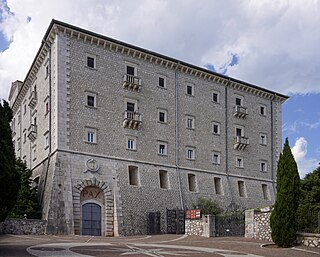
Monte Cassino is a rocky hill about 130 kilometres (80 mi) southeast of Rome, in the Latin Valley, Italy, 2 kilometres west of Cassino and at an elevation of 520 m (1,710 ft). Site of the Roman town of Casinum, it is widely known for its abbey, the first house of the Benedictine Order, having been established by Benedict of Nursia himself around 529. It was for the community of Monte Cassino that the Rule of Saint Benedict was composed.

Benevento is a city and comune of Campania, Italy, capital of the province of Benevento, 50 kilometres (31 mi) northeast of Naples. It is situated on a hill 130 metres above sea level at the confluence of the Calore Irpino and the Sabato. In 2020, Benevento has 58,418 inhabitants. It is also the seat of a Catholic archbishop.

The Sanctuary of Saint Michael the Archangel is a Roman Catholic shrine on Mount Gargano, Italy, part of the commune of Monte Sant'Angelo, in the province of Foggia, northern Apulia. It has the dignity of a minor basilica.

Catanzaro, also known as the "City of the two Seas", is an Italian city of 86,183 inhabitants (2020), the capital of the Calabria region and of its province and the second most populated comune of the region, behind Reggio Calabria.

Olivia of Palermo, Palermo, 448 – Tunis, 10 June 463, while according to another tradition she is supposed to have lived in the late 9th century AD in the Muslim Emirate of Sicily is a Christian virgin-martyr who was venerated as a local patron saint of Palermo, Sicily, since the Middle Ages, as well as in the Sicilian towns of Monte San Giuliano, Termini Imerese, Alcamo, Pettineo and Cefalù.

William of Montevergine, or William of Vercelli,, also known as William the Abbot, was a Catholic hermit and the founder of the Congregation of Monte Vergine, or "Williamites". He is venerated as a saint by the Roman Catholic Church.

Saint Renatus is the name of a French and an Italian saint of the Catholic Church who is claimed to be the same person. There are different stories of two saints with by the name Renatus, who were later merged into a single one based on their described similarities and contemporaneity. Both are venerated in Italy and France. They were: Saint Renatus of Sorrento, and Saint Renatus of Angers. Part of their stories seem to be a legend, part incomplete and part deficient historically documented.
Pandulf II the Old was the prince of Benevento from 981 and prince of Capua from 1008 or 1009 to his death, and was the son of Landulf III who was co-prince between 959 and 968. Pandulf was first associated as co-prince in 977.
Saint Proculus (Proclus) of Pozzuoli was martyred around 305 AD, according to Christian tradition, at the same time as Saint Januarius.
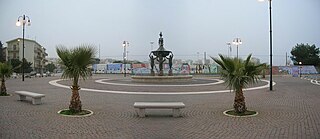
Siponto was an ancient port town and bishopric of Magna Graecia in Apulia, southern Italy. The town was abandoned after earthquakes in the 13th century; today the area is administered as a frazione of the comune of Manfredonia, in the province of Foggia. Siponto is located around 3 km south of Manfredonia.

Saint Severus was a bishop of Naples during the 4th and 5th centuries. He is considered the eleventh legitimate Catholic bishop of Naples, and the twelfth overall, succeeding Maximus. His episcopate ran from February 363 to April 29, 409, the traditional date of his death. Between the episcopates of Maximus and Severus, Zosimus, an Arian was established as Bishop, who was condemned as heretical by the Catholic Church.
Trofimena is a female saint canonised in the Roman Catholic Church. Originally from the town of Patti in Sicily, the relics of Trofimena are venerated in the basilica in the town of Minori, Italy on the coast of Amalfi, southern Italy.

Eleutherius, also written as Eleutherus, Eleuterus and Eleftherios; sometimes called Liberalis or Liberator, the former transliterations and the latter translations of his and his mother Antia are venerated as Christian saints and martyrs in Greece and Albania.

Bessus, sometimes Besse, is venerated as a member of the legendary Theban Legion, whose members were led by Maurice and were martyred for their Christian faith in the 3rd century. Except for the cult of Saint Maurice, veneration for Bessus enjoyed a wider popularity than those associated with other saints of the Theban Legion and remains popular today. According to tradition, Constantius survived the decimation of his legion and fled to valleys of Aosta and Cogne. He then dedicated himself to converting the people in this area to Christianity.
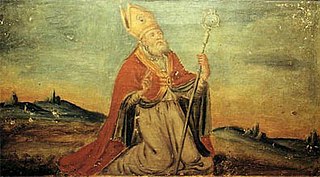
Saint Leucius was initially a missionary from Alexandria, Egypt, who later founded the Diocese of Brindisi, as the first Bishop in 165. It is believed that he later suffered martyrdom in 180.

Osimo Cathedral or the Church of San Leopardo is the principal church of Osimo in Italy, dedicated to the first bishop, Saint Leopardus. Formerly the episcopal seat of the Diocese of Osimo, it has been since 1986 a co-cathedral of the Archdiocese of Ancona-Osimo.

The Abbey of Santa Giustina is a 10th-century Benedictine abbey complex located in front of the Prato della Valle in central Padua, region of Veneto, Italy. Adjacent to the former monastery is the basilica church of Santa Giustina, initially built in the 6th century, but whose present form derives from a 17th-century reconstruction.
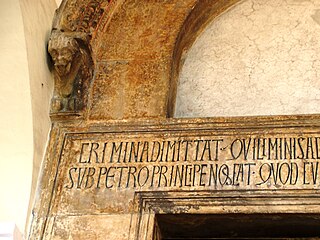
Robert was a south Italian nobleman who ruled the counties of Airola, Alife, Caiazzo, Sant'Agata and Telese from 1088 until his death. He was the regent of Capua in 1090–93, and was effectively independent of any lord after 1105. He was a major patron of churches and abbeys, and also commissioned several books.
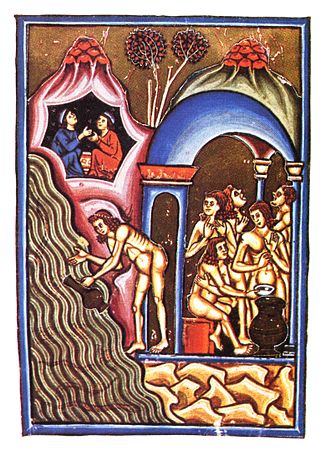
Germanus was the bishop of Capua from 519 or shortly before until his death. He played a major role in bringing to an end the Acacian schism, the first major schism that divided the Christian church between east and west.

Theodosius of Oria was a bishop and papal legate in the 9th century. He is venerated as a saint by the Catholic Church on August 30.